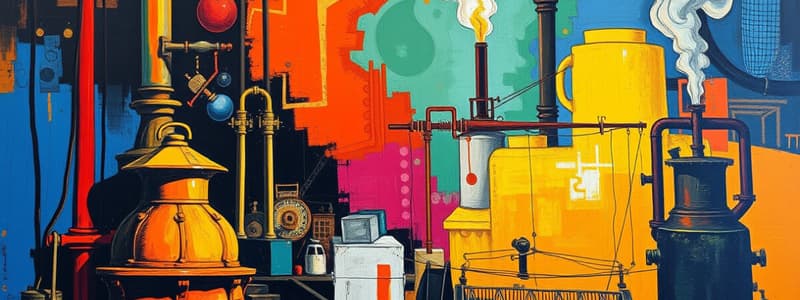Podcast
Questions and Answers
What was the purpose of the Spinning Jenny?
What was the purpose of the Spinning Jenny?
- To purify iron ore
- To send coded messages across wires
- To work eight threads at once (correct)
- To increase immunity to diseases
Who invented the Steam Engine?
Who invented the Steam Engine?
- Eli Whitney
- James Watt (correct)
- James Hargreaves
- Henry Ford
What is the main function of the Cotton Gin?
What is the main function of the Cotton Gin?
- To remove seeds from cotton (correct)
- To send messages
- To provide power to factories
- To manufacture interchangeable parts
What was the significance of Vaccinations?
What was the significance of Vaccinations?
What are Interchangeable Parts?
What are Interchangeable Parts?
Who developed the Telegraph?
Who developed the Telegraph?
What major material did Henry Bessemer's process produce?
What major material did Henry Bessemer's process produce?
What process did Louis Pasteur create for milk?
What process did Louis Pasteur create for milk?
What is the method used in an Assembly Line?
What is the method used in an Assembly Line?
Flashcards are hidden until you start studying
Study Notes
Spinning Jenny
- Invented by James Hargreaves in 1764 in Britain.
- Enabled a single spinner to work on eight threads simultaneously.
- Revolutionized the textile industry by increasing thread production and strength.
Steam Engine
- Developed by James Watt in 1765 in Britain.
- Utilizes coal as fuel, replacing the need for water power.
- Allowed factories to be situated away from rivers, enhancing industrial flexibility.
Cotton Gin
- Created by Eli Whitney in 1793 in the United States.
- Mechanically removed seeds from raw cotton.
- Boosted cotton cleaning efficiency and contributed to the expansion of slavery in the U.S.
Vaccinations
- Pioneered by Edward Jenner around 1798 in England.
- Involves injecting a virus or a related substance to build immunity against specific diseases.
- Significantly reduced mortality from diseases such as smallpox and rabies.
Interchangeable Parts
- Innovated by Eli Whitney in the early 1800s in the United States.
- Involves creating identical components for larger machines, initially applied to musket production.
- Simplified the assembly and maintenance processes across various products.
Telegraph
- Invented by Samuel Morse in 1837 in the United States.
- Utilizes electrical impulses to transmit coded messages over wires.
- Transformed communication by enabling rapid long-distance message delivery.
Steel
- Developed by Henry Bessemer in 1856 in Britain.
- Introduced a process to purify iron ore, resulting in lighter and stronger steel.
- Became a crucial material for tools, machinery, bridges, and railroads.
Pasteurization
- Formulated by Louis Pasteur around 1850 in France.
- Process kills disease-causing microbes in milk.
- Played a significant role in preventing the spread of foodborne illnesses.
Assembly Line
- Introduced by Henry Ford around 1908 in the United States.
- Revolutionized the production process by bringing tasks to workers, fostering specialization.
- Enabled mass production of automobiles and other goods, enhancing efficiency.
Studying That Suits You
Use AI to generate personalized quizzes and flashcards to suit your learning preferences.




